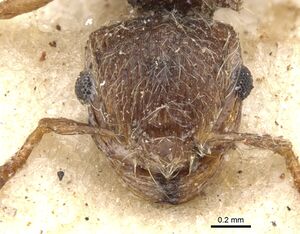Meranoplus peringueyi
| Meranoplus peringueyi | |
|---|---|

| |
| Scientific classification | |
| Kingdom: | Animalia |
| Phylum: | Arthropoda |
| Class: | Insecta |
| Order: | Hymenoptera |
| Family: | Formicidae |
| Subfamily: | Myrmicinae |
| Tribe: | Crematogastrini |
| Genus: | Meranoplus |
| Species: | M. peringueyi |
| Binomial name | |
| Meranoplus peringueyi Emery, 1886 | |
| Synonyms | |
| |
Identification
Keys including this Species
Distribution
Latitudinal Distribution Pattern
Latitudinal Range: -25.14424° to -34.71339°.
| North Temperate |
North Subtropical |
Tropical | South Subtropical |
South Temperate |
- Source: AntMaps
Distribution based on Regional Taxon Lists
Afrotropical Region: Lesotho, South Africa (type locality).
Distribution based on AntMaps
Distribution based on AntWeb specimens
Check data from AntWeb
Countries Occupied
| Number of countries occupied by this species based on AntWiki Regional Taxon Lists. In general, fewer countries occupied indicates a narrower range, while more countries indicates a more widespread species. |

|
Estimated Abundance
| Relative abundance based on number of AntMaps records per species (this species within the purple bar). Fewer records (to the left) indicates a less abundant/encountered species while more records (to the right) indicates more abundant/encountered species. |

|
Biology
Castes
Images from AntWeb
   
| |
| Syntype of Meranoplus excisus. Worker. Specimen code casent0902016. Photographer Will Ericson, uploaded by California Academy of Sciences. | Owned by NHMUK, London, UK. |
   
| |
| Syntype of Meranoplus peringueyi. Worker. Specimen code casent0904680. Photographer Z. Lieberman, uploaded by California Academy of Sciences. | Owned by MSNG, Genoa, Italy. |
Nomenclature
The following information is derived from Barry Bolton's Online Catalogue of the Ants of the World.
- peringueyi. Meranoplus peringueyi Emery, 1886: 365, pl. 17, fig. 12 (w.) SOUTH AFRICA.
- Type-material: syntype workers (number not stated).
- Type-locality: South Africa: Cape of Good Hope (L. Peringuey).
- Type-depositories: MHNG, MRAC, MSNG, NHMB.
- [Misspelled as peringuei by Forel, 1913a: 116.]
- Status as species: Dalla Torre, 1893: 137; Forel, 1913a: 116; Arnold, 1917: 368; Wheeler, W.M. 1922a: 888; Emery, 1924d: 227; Bolton, 1981a: 56 (redescription); Bolton, 1995b: 251.
- Senior synonym of excisus: Bolton, 1981a: 56; Bolton, 1995b: 251.
- Distribution: Lesotho, South Africa.
- excisus. Meranoplus excisus Arnold, 1914: 29, fig. 9 (w.) SOUTH AFRICA.
- Type-material: syntype workers (number not stated).
- Type-locality: South Africa: Natal, Estcourt (R.C. Wroughton).
- Type-depositories: BMNH, SAMC.
- Status as species: Arnold, 1917: 367; Wheeler, W.M. 1922a: 888; Emery, 1924d: 227.
- Junior synonym of peringueyi: Bolton, 1981a: 56; Bolton, 1995b: 251.
Description
References
- Arnold, G. 1914. Nest-changing migrations of two species of ants. Proc. Trans. Rhod. Sci. Assoc. 13: 25-32.
- Baer, B. 2011. The copulation biology of ants (Hymenoptera: Formicidae). Myrmecological News 14: 55-68.
- Bolton, B. 1981a. A revision of the ant genera Meranoplus F. Smith, Dicroaspis Emery and Calyptomyrmex Emery (Hymenoptera: Formicidae) in the Ethiopian zoogeographical region. Bull. Br. Mus. (Nat. Hist.) Entomol. 42: 43-81 (page 56, Senior synonym of excisus)
- Cantone S. 2017. Winged Ants, The Male, Dichotomous key to genera of winged male ants in the World, Behavioral ecology of mating flight (self-published).
- Devenish, A.J.M., Newton, R.J., Bridle, J.R., Gomez, C., Midgley, J.J., Sumner, S. 2021. Contrasting responses of native ant communities to invasion by an ant invader, Linepithema humile. Biological Invasions 23, 2553–2571 (doi:10.1007/s10530-021-02522-7).
- Emery, C. 1886b. Alcune formiche africane. Bull. Soc. Entomol. Ital. 18: 355-366 (page 365, pl. 17, fig. 12 worker described)
References based on Global Ant Biodiversity Informatics
- Arnold G. 1917. A monograph of the Formicidae of South Africa. Part III. Myrmicinae. Annals of the South African Museum. 14: 271-402.
- Bolton B. 1981. A revision of the ant genera Meranoplus F. Smith, Dicroaspis Emery and Calyptomyrmex Emery (Hymenoptera: Formicidae) in the Ethiopian zoogeographical region. Bull. Br. Mus. (Nat. Hist.) Entomol. 42: 43-81.
- Dean, W. R. J. and Bond, W. J. 1990. Evidence for Rapid Faunal Changes on Islands in a Man-Made Lake. Oecologia. 83:388-391.
- Forel A. 1913. Fourmis de Rhodesia, etc. récoltées par M. G. Arnold, le Dr. H. Brauns et K. Fikendey. Annales de la Société Entomologique de Belgique 57: 108-147.
- IZIKO South Africa Museum Collection
- Koen J. H., and W. Breytenbach. 1988. Ant species richness of fynbos and forest ecosystems in the Southern Cape. South Afr. Tydskr. Dierk. 23(3): 184-188.
- Kotze D. J., and M. J. Samways. 2001. No general edge effects for invertebrates at Afromontane forest/grassland ecotones. Biodiversity and Conservation 10: 443466.
- Kotze D. J., and M. J. Samways. Invertebrate conservation at the interface between the grassland matrix and natural Afromontane forest fragments. 1999. Biodiversity and Conservation 8: 1339-1363.
- Wheeler W. M. 1922. Ants of the American Museum Congo expedition. A contribution to the myrmecology of Africa. VIII. A synonymic list of the ants of the Ethiopian region. Bulletin of the American Museum of Natural History 45: 711-1004
- van Hamburg H., A. N. Andersen, W. J. Meyer, and H. G. Robertson. 2004. Ant community development on rehabilitated ash dams in the South African highveld. Restoration Ecology 12(4): 552-558.

